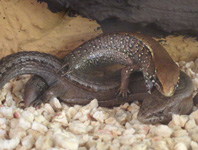Abstract
Tetraglossula ranges from southern Pará state, Brazil, through central South American (occurring in different biomes: Cerrado savanna, Chaco, and Atlantic forest) southward to the Pampa reaching the province of Buenos Aires, Argentina. Hitherto, four species have been recognized in Tetraglossula Ogloblin, 1948: T. anthracina (Michener, 1989); T. bigamica (Strand, 1910); T. deltivaga Ogloblin, 1948; and T. fucosa (Michener, 1989). Herein, we transfer Bicolletes franki Friese, 1908 to Tetraglossula, and one new species is described: Tetraglossula meloi Almeida & Gibran, sp.n. An identification key is provided for the resulting six species now recognized in Tetraglossula.
References
Almeida, E.A.B. (2008) Revised species checklist of the Paracolletinae (Hymenoptera, Colletidae) of the Australian Region, with the description of new taxa. Zootaxa, 1891, 1–24.
Almeida, E.A.B. & Danforth, B.N. (2009) Phylogeny of colletid bees (Hymenoptera: Colletidae) inferred from four nuclear genes. Molecular Phylogenetics and Evolution, 50, 290–309.
https://doi.org/10.1016/j.ympev.2008.09.028Almeida, E.A.B. & Quinteiro, F.B. (2015) Two continents and two names for a Neotropical colletid bee species (Hymenoptera: Colletidae: Neopasiphaeinae): Hoplocolletes ventralis (Friese, 1924). PeerJ, 3, e1338.
https://doi.org/10.7717/peerj.1338Almeida, E.A.B., Pie, M.R., Brady, S.G. & Danforth, B.N. (2012) Biogeography and diversification of colletid bees (Hymenoptera: Colletidae): Emerging patterns from the Southern End of the World. Journal of Biogeography, 39, 526–544. https://doi.org/10.1111/j.1365-2699.2011.02624.x
Brothers, D.J. (1976) Modifications of the metapostnotum and origin of the ‘propodeal triangle’ in Hymenoptera Aculeata. Systematic Entomology, 1, 177–182.
https://doi.org/10.1111/j.1365-3113.1976.tb00036.xCarvalho, A.T. & Schlindwein, C. (2011) Obligate association of an oligolectic bee and a seasonal aquatic herb in semi-arid north-eastern Brazil. Biological Journal of the Linnean Society, 102, 355–368.
https://doi.org/10.1111/j.1095-8312.2010.01587.xFriese, H. (1908) Die Apidae (Blumenwespen) von Argentina nach den Reisenergebnissen der Herren A. C. Jensen-Haarup und P. Jörgensen in den Jahren 1904-1907. Flora og Fauna, 10, 1–94.
https://doi.org/10.5962/bhl.title.14257Gaglianone, M.C. (2000) Behavior on flowers, structures associated to pollen transport and nesting biology of Perditomorpha brunerii and Cephalurgus anomalus (Hymenoptera: Colletidae, Andrenidae). Revista de Biología Tropical, 48, 89–99.
Gimenes, M. (1991) Some morphological adaptations in bees (Hymenoptera, Apoidea) for collecting pollen from Ludwigia elegans (Onagraceae). Revista Brasileira de Entomologia, 35, 413–422.
Gimenes, M. (2002) Interactions between bees and Ludwigia elegans (Camb.) Hara (Onagraceae) flowers at different altitudes in São Paulo, Brazil. Revista Brasileira de Zoologia, 19, 681–689.
https://doi.org/10.1590/S0101-81752002000300005Gimenes, M. (2003) Interaction between visiting bees (Hymenoptera, Apoidea) and flowers of Ludwigia elegans (Camb.) Hara (Onagraceae) in São Paulo, Brazil. Brazilian Journal of Biology, 63, 617–625.
https://doi.org/10.1590/S1519-69842003000400008Harris, R.A. (1979) A glossary of surface sculpturing. California Department of Food and Agriculture. Laboratory Services, Entomology. Occasional Papers, 28, 1–31.
Houston, T.F. (2000) Native Bees on Wildflowers in Western Australia. A Synopsis of Native Bee Visitation of Wildflowers in Western Australia Based on the Bee Collection of the Western Australian Museum. Special Publication No. 2 of the Western Australian Insect Study Society Inc. Australia, Western Australian Museum, Perth, 235 pp.
Laroca, S., Michener, C.D. & Hoffmeister, R.M. (1989) Long mouthparts among "short-tongued" bees and the fine structure of the labium in Niltonia. Journal of the Kansas Entomological Society, 62, 400–410.
Linsley, E.G. (1958) The ecology of solitary bees. Hilgardia, 27, 543–599.
https://doi.org/10.3733/hilg.v27n19p543Melo, G.A.R. (1996) Two new Brazilian bees of the genus Protodiscelis (Hymenoptera, Colletidae). Revista Brasileira de Entomologia, 40, 97–100.
Michener, C.D. (1965) A classification of the bees of the Australian and South Pacific regions. Bulletin of the American Museum of Natural History, 130, 1–362, pls. 1–15.
Michener, C.D. (1989) Classification of the American Colletinae. University of Kansas Science Bulletin, 53, 622–703.
Michener, C.D. (2007) The Bees of the World. 2nd Edition. John Hopkins University Press, Baltimore, xvi + 992 pp.
Moure, J.S. (1951) Notas sobre abelhas do antigo gênero Pasiphae (Hymenopt.- Apoidea). Dusenia, 2, 189–198.
Moure, J.S., Graf, V. & Urban, D. (1999) Catálogo de Apoidea da região Neotropical (Hymenoptera, Colletidae). I. Paracolletini. Revista Brasileira de Zoologia, 16 (Supplement 1), 1–46.
https://doi.org/10.1590/s0101-81751999000500001Moure, J.S., Graf, V. & Urban, D. (2012) Paracolletini Cockerell, 1934. In: Moure, J. S., Urban, D. & Melo, G.A.R. (Orgs.), Catalogue of Bees (Hymenoptera, Apoidea) in the Neotropical Region—online version. Available from: http://www.moure.cria.org.br/catalogue (accessed 21 January 2017)
Oglobin, A. (1948) Descripción de dos géneros nuevos de Paracolletini argentinos (Colletidae, Apoidea, Hymenoptera). Notas del Museo de La Plata, Zoologia, 13 (106), 165–177.
Porto, D.S., Vilhelmsen, L. & Almeida, E.A.B. (2016) Comparative morphology of the mandibles and head structures of corbiculate bees (Hymenoptera: Apidae: Apini). Systematic Entomology, 41, 339–368.
https://doi.org/10.1111/syen.12156Roig-Alsina, A. (2006) A new species of Hexantheda Ogloblin (Hymenoptera, Colletidae), a genus of bees with labial palpi of variable number of segments. Zootaxa, 1229, 33–40.
Schlindwein, C. (1998) Frequent oligolecty characterizing a diverse bee–plant community in a xerophytic bushland of subtropical Brazil. Studies on Neotropical Fauna and Environment, 33, 46–59.
https://doi.org/10.1076/snfe.33.1.46.2168Shorthouse, D. (2010) SimpleMappr, an online tool to produce publication-quality point maps. Available from: http://www.simplemappr.net (accessed 30 January 2017)
Silveira, F.A., Melo, G.A.R. & Almeida & E.A.B. (2002) Abelhas Brasileiras: Sistemática e Identificação. Published by the authors, Belo Horizonte, 253 pp.
Stehmann, J.R. & Semir, J. (2001) Biologia reprodutiva de Calibrachoa elegans (Miers) Stehmann & Semir (Solanaceae). Revista Brasileira de Botânica, 24, 43–49.
https://doi.org/10.1590/s0100-84042001000100005Strand, E. (1910) Beiträge zur Kenntnis der Hymenopterenfauna von Paraguay. Zoologische Jahrbücher. Abteilung für Systematik, Geographie und Biologie der Tiere, 29, 455–562.
Trucco-Alemán, M.F. (1999) Revisión del género de abejas Brachyglossula Hedicke (Hymenoptera, Colletidae). Revista del Museo Argentino de Ciencias Naturales, 1, 181–189.
https://doi.org/10.22179/REVMACN.1.134

